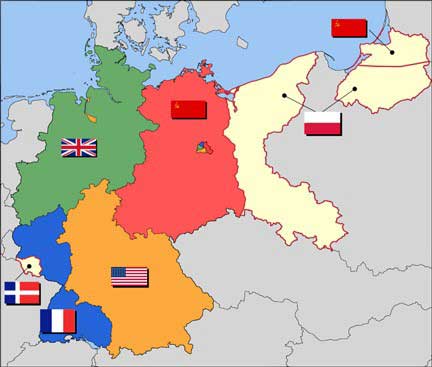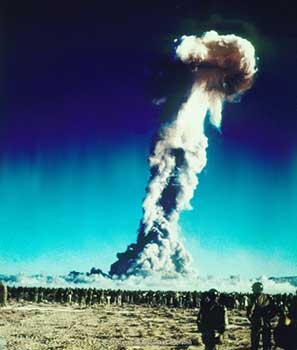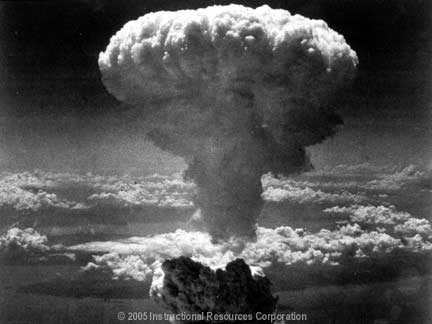Learn
 8.04 Notes Outline
8.04 Notes Outline
RecapThe End of World War II In Europe: Hitler was defeated at the Battle of the Bulge in early 1945. The Soviets entered Berlin, Germany on April 17, 1945, followed by the Americans. Hitler committed suicide on April 30th and Germany officially surrendered on May 8, 1945. Over 50 million soldiers and civilians died in WWII, including 300,000 U.S. troops. In the Pacific: By the time Truman became president in 1945, Allied forces were winning the war in the Pacific. The Battles of Iwo Jima and Okinawa were costly and bloody, but America demonstrated their ability to defeat Japan. Postdam ConferenceFollowing Germany's surrender, Allied leaders met in Potsdam, Germany for their last conference of the war. At the conference the Allies called for Japan to surrender. Japan refused to surrender.
The 'Big Three' meeting at Potsdam. IRC. 2005. Discovery Education. 23 January 2010. During the Potsdam conference, the Allied leaders divided Germany into four zones of occupation, with each major Allied power controlling a zone.
Occupation zone borders in Germany, 1947. CC BY SA 2.5. The A-BombThe Manhattan ProjectThe Manhattan Project, headed by Robert Oppenheimer, was a top secret plan to develop an atomic bomb in Los Alamos, New Mexico. It was Albert Einstein, a Jewish physicist who had sought refuge in America from the Nazis, who suggested to FDR that such a powerful weapon could be built. The world's first atomic bomb was tested in the New Mexico desert. It was so powerful that even its designer thought it should not be used. Read more about the Manhattan Project.
Troops Observe an A-bomb Explosion IRC, 2005. Image. Discovery Education. Web. 28 July 2014. Hiroshima and NagasakiDesperate to bring the war to an end with as few casualties as possible, President Truman made the call to drop the atomic bomb on Hiroshima and Nagasaki in August 1945 rather than invade Japan. Though controversial, the decision did ultimately lead to the immediate end of World War II.
Map of Japan with location of Hiroshima and Nagasaki. CC BY SA 3.0 On August 6, 1945, a plane called the Enola Gay dropped an atomic bomb on Hiroshima, the site of a large army base in southern Japan. An estimated 140,000 people died from the immediate explosion or within a few months from after effects and 90% of the city's buildings were destroyed.
Enola Gay after dropping the first bomb
Hiroshima, Japan, after the atomic bomb blast
Hiroshima after the atomic bomb blast Japan still refused to surrender. Three days later a 2nd bomb was dropped on Nagasaki causing similar destruction.
The dropping of the atomic bomb on Nagasaki, Japan V-J DayOn Aug. 14, 1945, after enduring two atomic bombs, Japan agreed to surrender, ending World War II once and for all. The day after the surrender, Americans celebrated V-J Day, or Victory in Japan Day.
"New York City celebrating the surrender of Japan. They threw anything and kissed anybody in Times Square." Photo by Alfred Eisenstaedt, taken on V-J Day, 1945, published in Life Magazine. The formal surrender took place on September 2, 1945. Japan surrendered to U.S. and Allied forces in a ceremony on the battleship U.S.S. Missouri.
The Japanese surrender. IRC. 2005. Discovery Education. 28 July 2014. ResultsWar CriminalsAs the war reached its end in 1945, Allies became aware of the horrific crimes that had been committed. Both the Nazis in Europe and Japanese leaders in the Pacific had committed appalling atrocities throughout the war. The United States, Great Britain, France, and the Soviet Union established an International Military Tribunal to prosecute the war criminals of World War II. The Tribunal conducted two series of trials:
The defendants at the International Military Tribunal trial of war criminals at Nuremberg. Courtesy of the United States Holocaust Memorial Museum and the National Archives and Records Administration Landmark PrecedentsThe Tribunal had unique jurisdiction because it covered offenses that did not necessarily have geographic limits. For example, it charged people with crimes against "human dignity." Ultimately, this Tribunal and the trials set the precedent for all future international criminal courts. The defendants had two main arguments:
The courts rejected both arguments:
To help clarify what constituted a "crime against humanity" for all future war crimes, the United Nations adopted a Universal Declaration of Human Rights (UDHR) on December 10, 1948. The United Nations also established the Genocide Convention to prevent and punish the crime of genocide, which is the deliberate killing of a large number of people from a particular nation or ethnic group with the aim of destroying that nation or group. The Holocaust was an act of genocide against the Jewish people. Both of these pieces of international law are a direct result of the experiences during World War II. The Universal Declaration of Human Rights (UDHR) and the Genocide Convention establish minimum standards for the conduct of all participating countries to eradicate the use of genocide in times of war and peace and to establish the fundamental requirements for human dignity. The Convention criminalized certain acts committed with the intent to destroy ethnic, national, racial, or religious groups. The documents are still used today by the United Nations and referenced during trials at the International Criminal Court. Read more about the UDHR from the United Nations. |










